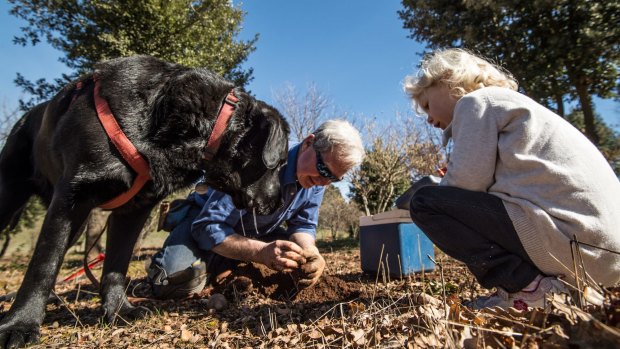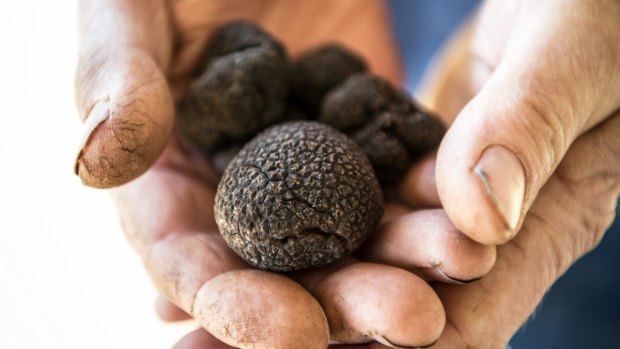This was published 5 years ago
Truffle hunting in Oberon, NSW: Why are truffles so expensive?

Col Roberts hunts for truffles with his loyal labrador Floyd.Credit: Wolter Peeters
A thick frost cloaks the hills on this winter's morn around Oberon, west of Sydney's Blue Mountains.
Yet Floyd, a huge black five-year-old labrador, is hard at work at Lowes Mount Truffiere. His sensitive nose is poised above the acorn-strewn ground surrounding the spore-infected rows of English and evergreen oaks.
Every so often Floyd makes a light paw scrape showing he's detected the pungent aroma of the fungus known to chefs as "black gold".

Lowes Mount Truffiere truffles from Oberon. Credit: Wolter Peeters
That's the signal for Col Roberts – one of NSW's leading trufficulteurs – to kneel down, gently mine the potential site with his home-made metal scalpel, and take a deep sniff.
So Floyd does all the hard work then?
"Of course he does," answers Roberts, through gritted teeth. He's a retired district forester once responsible for the extensive state forests that make Oberon a full employment "timber town" almost two centuries since the area was settled by Europeans.
A well-trained truffle dog is indispensable to a successful truffiere (pronounce it "true-fee-air"), he admits. But who trained the dog?
"It's Floyd's job to find the truffle … but my responsibility to decide whether it's ripe enough to be harvested," Roberts continues.
Also Floyd, Roberts points out testily, didn't select the three original types of trees (there used to be hazel trees), or tend them for 16 years.
Today Australia rivals France, Italy and Spain as one of the largest producers of the mysterious edible fungus that has been considered a delicacy since before the days of Plutarch.
Most are grown in Western Australia. Here on the east coast, from the Queensland border to Tasmania, truffle farming is more of a family labour of love.
"Most Australians go into the truffle industry for the romance," Roberts explains. "They don't realise there's hard work involved. You need a trained dog, but you also need be to be good at growing trees. Some people should steer clear of both."
Lowes Mount Truffiere has been running its Saturday "Hunter Lunch Experience" since 2012. It's usually fully booked for the notoriously short winter season (June-August, though it is getting shorter each year) within days of appearing on its website each New Year.
Most customers live in the Sydney basin, Roberts explains: "They're either foodies or people who love watching a working dog in action."
Either way, they'll get a good feed.
"We begin with a talk about what truffle is, how we established our truffiere, and why," Roberts says. "We also talk about the dog training involved before we go out into the truffiere with Floyd and go hunting for 45 minutes."
The group (of up to 20) then returns to the property's purpose-built lecture room and dining hall.
"We explain how truffles are prepared and what they should look for in a truffle being sold in their local farmers' market," Roberts continues.
And that is? "Ripeness. Study the grader's nick which shows the colour of the meat. It should have a good truffle aroma and be free of any rot or insect defect."
Now comes the highpoint: the truffle taste test.
The most commonly asked questions about truffles are: why are they so expensive? And why are they considered a delicacy?
Roberts and Floyd have answered the first question. It's trial and error, especially after 18 months of drought. Only one in 20 of Floyd's discoveries today reveal a ripe, marketable truffle.
Of those Roberts feels worthy of digging up, less than a handful – after a sharp, small slice of a penknife – reveal the aroma and "colour of the meat" that will earn a good price.
Pigs were the natural predators of the truffle. With their keen snouts and greedy appetites they dug up truffles, devoured them hungrily and then spread the spores as nature intended. How gourmet.
The Perigord black variant, Tuber melanosporium, which we have in Australia, was discovered in France's Provencal, though the much rarer and more expensive white variety Tuber magnatum, has never been successfully transplanted outside Italy.
Pigs had a particular problem when they were used as truffle hunters: they weren't worried whether they ate the truffles or the farmer's fingers.
So dogs like Floyd – happy to work for a tidbit and a hug – do the job instead.
As for what makes truffle special, Roberts' wife, Sue, has produced a $3 mini recipe book of suggestions.
There's truffled Brie, truffled lavosh, scrambled eggs with truffle and chives, pasta with truffle sauce, truffled potato soup and truffled pannacotta and truffled ice-cream (yes truffle can be an ingredient in desserts).
Tuck in, enjoy – and think of Floyd, happy with dog food.
TRIP NOTES
Steve Meacham travelled as a guest of Central NSW Tourism.
MORE
traveller.com.au/new-south-wales
TOUR
$95 per person, including truffle lunch with wine. See lowesmounttruffles.com.au
STAY
Mutton Falls B&B is a historic 1840s homestead, raided by bushrangers three times in the 19th century, and exquisitely renovated – just 10 minutes' drive from Lowes Mount Truffles. See muttonfalls.com.au
Sign up for the Traveller Deals newsletter
Get exclusive travel deals delivered straight to your inbox. Sign up now.